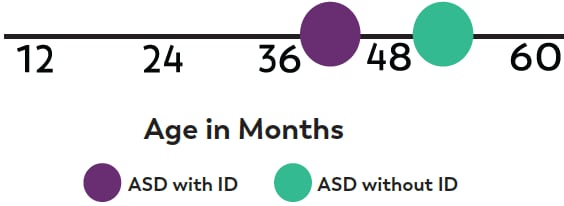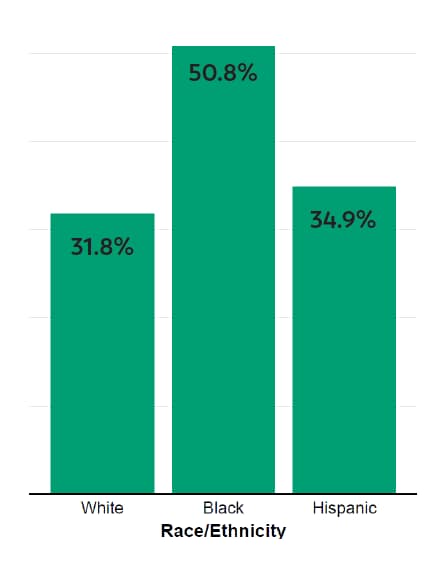Spotlight On A New Pattern in Racial and Ethnic Differences Emerges in Autism Spectrum Disorder (ASD) Identification among 8-year-old Children
‹View Table of Contents
For the first time, the ADDM Network data found the percentage of 8-year-old children identified with ASD was higher among Black, Hispanic, and Asian or Pacific Islander (A/PI) children compared with White children.

Values indicate prevalence per 1,000 children
Prior to 2016, the percentage of children identified with ASD by 8 years of age was higher among White children than among Black or Hispanic children. In recent years, differences in identification of ASD by race and ethnicity began to narrow. In fact, in 2018, there was no overall difference observed in the percentage of A/PI, Black, Hispanic, or White children identified with ASD by 8 years of age.

Also in 2018, a new pattern emerged in racial and ethnic differences among younger children, where the percentage of Black and Hispanic 4-year-old children identified with ASD was higher compared with White children aged 4 years. This pattern continued in 2020 among 4-year-old children and was seen for the first time among 8-year-old children.
These findings may indicate improvements in ASD awareness, identification, and access to services in communities serving Black, Hispanic, and A/PI children. If these findings do reflect improved identification among historically under served populations, it may be helpful to examine factors, such as social determinants of health, that could lead to higher rates of disability.
Reported differences in intellectual ability continue across ADDM sites
Intellectual disability (ID*) is often seen in children with ASD and can affect a person’s ability to learn at an expected level and function in daily life. Among 8-year-old children with ASD, more than one third (37.9%) also had ID
Children with ASD and ID

*Intellectual disability (ID) = IQ < 70
On average, 8 year-old children with ID were diagnosed with ASD earlier than those without ID
[age by which half of ASD diagnoses occurred: 43 months (with ID) versus 53 months (without ID)].

Although progress has been made in the identification of ASD among children of all races and ethnicities, concerns remain around the percentage of Black children identified with ASD who also had ID (50.8% among 8-year-olds). This percentage is higher than for Hispanic (34.9%) or White (31.8%) children and remains consistent with previous reports from the ADDM Network.


Future Directions
The ADDM Network will continue to monitor the number and characteristics of children with ASD over time. States and communities have the potential to turn this ADDM Network data into action.
Data can provide early awareness of important public health trends, such as the new pattern in racial and ethnic differences which was first observed in 2018 among 4-year-old children identified with ASD and has since emerged in older children (8-year-olds). With this information, states and communities can plan and develop strategies to promote awareness and improve identification of ASD and referral to services.
More work is also needed to understand why the ADDM Network continues to find a higher percentage of Black children identified with ASD and ID when compared to other racial and ethnic groups. The continued increase in children identified with ASD—particularly among Black, Hispanic, and A/PI children and among girls—highlights the importance of equitable diagnostic, treatment, and support services for all children with ASD. Like previous reporting periods, there were considerable differences in findings across network sites, suggesting the need for more research to understand the reason for such differences and to develop successful identification strategies that can be applied across states.
Pages in this Report
- 2023 Community Report on Autism
- Executive Summary
- Key Findings from the ADDM Network
- A Deeper Dive
- Spotlight On: Progress in Early Identification Disrupted during the COVID-19 Pandemic
- ›Spotlight On: A New Pattern in Racial and Ethnic Differences
- Data for Action
- ADDM Network Site Snapshots Overview
- A Snapshot of Autism Spectrum Disorder in Arizona
- A Snapshot of Autism Spectrum Disorder in Arkansas
- A Snapshot of Autism Spectrum Disorder in California
- A Snapshot of Autism Spectrum Disorder in Georgia
- A Snapshot of Autism Spectrum Disorder in Maryland
- A Snapshot of Autism Spectrum Disorder in Minnesota
- A Snapshot of Autism Spectrum Disorder in Missouri
- A Snapshot of Autism Spectrum Disorder in New Jersey
- A Snapshot of Autism Spectrum Disorder in Tennessee
- A Snapshot of Autism Spectrum Disorder in Utah
- A Snapshot of Autism Spectrum Disorder in Wisconsin
- Glossary
- References